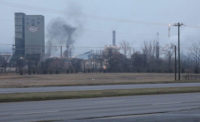...with only one for heavy vehicles. ODA set up two logistics command centers at nearby locations outside the park, which serve all deliveries. And it reestablished a rail yard on site. Contractors choose their own transportation mode.
Some 2.1 million tonnes of goods have been moved by rail, saving an estimated 170,000 tonnes of carbon dioxide, according to Payne. But ODA’s early hopes of delivering goods using the waterways crossing the site were frustrated by utility infrastructure that was in the way.
Before construction could start, the site needed cleaning and its profile reshaping. More than a century’s use had created over 250 hectares of derelict land, crossed by 19th Century waterways.
There were also hundreds of viable businesses on the site that needed relocation, says Saphira Sharif, a deputy project manager with W.S. Atkins.
Her team, among the first on site in late 2006, was charged with soil remediation planning and design. Some 500 individual packages of land were processed and progressively handed over to building teams.
Some 3,000 bore holes led to discoveries of chemical and fertilizer plants, and discarded World War II building rubble. Cruise also found two million used tires.
Soil treatments include bioremediation and stabilization, but most of the soil was washed to produce sand and gravel for concrete production and other site uses. Polluted residue went off-site for disposal.
In order to achieve required site contours, crews shifted about 2 million cu m of earth. Of that, workers remediated about 900,000 cu m. Crews hauled about 200,000 cu m of the residue to landfill. They reused the rest on site. They also reused over 90% of the building rubble.
By summer 2009, workers had finished 90% of the site preparation. They expect to complete the work by year’s end, says Sharif. With the soil cleaned, the infrastructure team moved in, initially to bury overhead power lines. Two new six-km-long cable tunnels, 4.1 m and 2.8 m in diameter, cross the site along with extensive power, water and telecommunications networks.
Work also includes building 14 new bridges. There will be a total of 22, says Bill Grose, Arup’s infrastructure project director. “They are really a continuation of the landscape [with], no structure above the general ground level other than the parapet,” he adds.
With three-quarters of construction done, the program is in good financial shape, according to the most recent statistics from the Dept. of Culture, Media and Sport, released in July.
The expected cost of infrastructure and regeneration has moved little from its 2007 budget. But the allocation for site security during construction more than trebled, to $420 million.
Venue budgets have remained virtually unchanged. But the Aquatic Centre is heading for a 20% overrun, attributed to its complexity and site conditions.
The main responsibility for managing the transfer of the remaining facilities and creating a new community over the coming years lies with the government’s Olympic Park Legacy Co., set up in October 2009. ODA has yet to tap into its budget for removing temporary venues and facilities after the games end. Planning for the long term, ODA last month began looking for an investor to take over the Olympic Village and convert it into residences.
With much done, it’s still not time to relax. “The last 10% of the job is always the toughest,” says CLM’s Szomjassy. “We really have to stay focused.”
The patchy history of Olympic construction projects has left countless white elephants in its wake. With the project’s attention to sustainability and legacy, many players, including Szomjassy, think the city is setting a model for future games. The extravagant and disruptive construction preceding the 2008 Beijing Olympics is a thing of the past, he says.
$ 14.7 | billion budgeted for the entire event |
|---|---|
$ 8.4 | billion increase from bid estimate |
$ 950 | million budgeted for security |
10,300 | peak workforce |
3,000 | subcontractors building Olympic Park |
250 | hectares of derelict land reclaimed |
17,000 | athletes housed in Olympic Village |
75% | of construction budget intended for posterity |
50% | carbon-reduction goal for development |
10,000 | pages for planning application |
20% | projected cost overrun for aquatic center |








Post a comment to this article
Report Abusive Comment